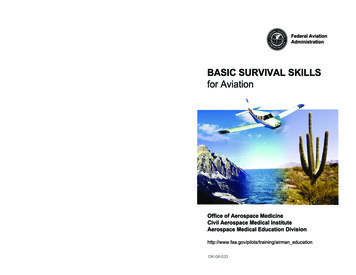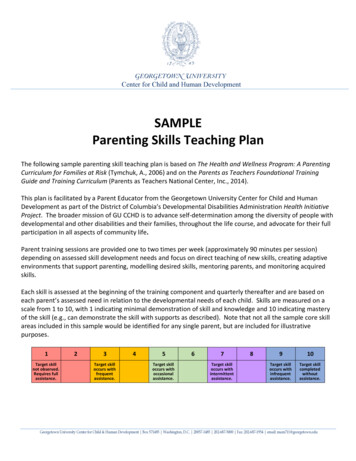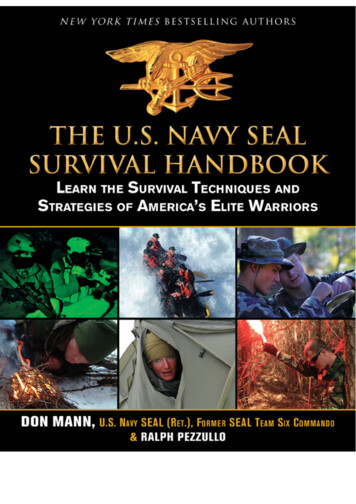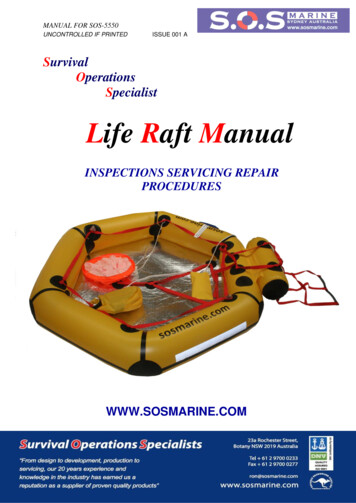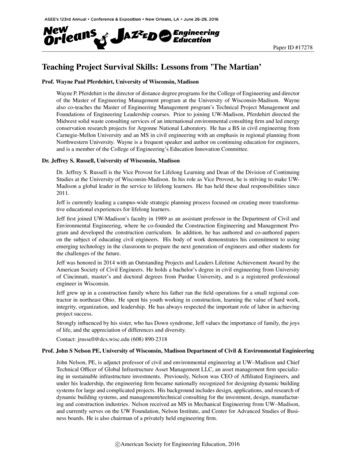
Transcription
Paper ID #17278Teaching Project Survival Skills: Lessons from ’The Martian’Prof. Wayne Paul Pferdehirt, University of Wisconsin, MadisonWayne P. Pferdehirt is the director of distance degree programs for the College of Engineering and directorof the Master of Engineering Management program at the University of Wisconsin-Madison. Waynealso co-teaches the Master of Engineering Management program’s Technical Project Management andFoundations of Engineering Leadership courses. Prior to joining UW-Madison, Pferdehirt directed theMidwest solid waste consulting services of an international environmental consulting firm and led energyconservation research projects for Argonne National Laboratory. He has a BS in civil engineering fromCarnegie-Mellon University and an MS in civil engineering with an emphasis in regional planning fromNorthwestern University. Wayne is a frequent speaker and author on continuing education for engineers,and is a member of the College of Engineering’s Education Innovation Committee.Dr. Jeffrey S. Russell, University of Wisconsin, MadisonDr. Jeffrey S. Russell is the Vice Provost for Lifelong Learning and Dean of the Division of ContinuingStudies at the University of Wisconsin-Madison. In his role as Vice Provost, he is striving to make UWMadison a global leader in the service to lifelong learners. He has held these dual responsibilities since2011.Jeff is currently leading a campus-wide strategic planning process focused on creating more transformative educational experiences for lifelong learners.Jeff first joined UW-Madison’s faculty in 1989 as an assistant professor in the Department of Civil andEnvironmental Engineering, where he co-founded the Construction Engineering and Management Program and developed the construction curriculum. In addition, he has authored and co-authored paperson the subject of educating civil engineers. His body of work demonstrates his commitment to usingemerging technology in the classroom to prepare the next generation of engineers and other students forthe challenges of the future.Jeff was honored in 2014 with an Outstanding Projects and Leaders Lifetime Achievement Award by theAmerican Society of Civil Engineers. He holds a bachelor’s degree in civil engineering from Universityof Cincinnati, master’s and doctoral degrees from Purdue University, and is a registered professionalengineer in Wisconsin.Jeff grew up in a construction family where his father ran the field operations for a small regional contractor in northeast Ohio. He spent his youth working in construction, learning the value of hard work,integrity, organization, and leadership. He has always respected the important role of labor in achievingproject success.Strongly influenced by his sister, who has Down syndrome, Jeff values the importance of family, the joysof life, and the appreciation of differences and diversity.Contact: jrussell@dcs.wisc.edu (608) 890-2318Prof. John S Nelson PE, University of Wisconsin, Madison Department of Civil & Environmental EnginieeringJohn Nelson, PE, is adjunct professor of civil and environmental engineering at UW–Madison and ChiefTechnical Officer of Global Infrastructure Asset Management LLC, an asset management firm specializing in sustainable infrastructure investments. Previously, Nelson was CEO of Affiliated Engineers, andunder his leadership, the engineering firm became nationally recognized for designing dynamic buildingsystems for large and complicated projects. His background includes design, applications, and research ofdynamic building systems, and management/technical consulting for the investment, design, manufacturing and construction industries. Nelson received an MS in Mechanical Engineering from UW–Madison,and currently serves on the UW Foundation, Nelson Institute, and Center for Advanced Studies of Business boards. He is also chairman of a privately held engineering firm.c American Society for Engineering Education, 2016
Adapting Graduate Project Management Educationfor Practicing Professionals to the High-Stakes, Turbulent Worldwhere Projects Live or DieIntroductionThe popularity of the movie 1 and book 2, “The Martian,” provide an interesting and helpfullaunching point for reconsidering what it takes to be an effective project manager in today’sworld where projects must often adapt with agility to changing conditions or fail.In “The Martian,” astronaut, mechanicalengineer, and botanist Mark Watney is leftbehind on Mars when the team needs to rapidlyevacuate due to a sudden sand storm. Watneyis presumed dead after being hit by flyingdebris and the team is unable to rescue his bodybefore the ship needs to launch to avoidtragedy. Watney regains consciousness, onlyto discover has team has left and he needs tofigure out some way to stay alive long enough,with very limited food, oxygen, and supplies, topossibly rendezvous with a return mission toMars in four years. Realizing his predicament, Figure 1:3 Photo, credit 20th Century Fox, BusinessInsiderWatney, speaking to his camera diary, says,"I'm gonna have to science the shit out of this."Watney’s reaction is a life-or-death version of the reaction that real-world project managers feelat some visceral level when their projects take some major, unexpectedly bad turn. Virtually allprojects, even those best planned, funded, and credit staffed, face these externally imposeddilemmas when world events, markets, or the forces of nature throw a major curve ball at aseemingly well-planned project.Watney survives because he has education and experience that give him the needed scienceknowledge, but also because he has a deep reserve of courage, resilience, emotional intelligence,and effective adaptability to the challenge before him. Near the conclusion of the movie, Watneyis speaking to a class of astronauts in training. Watney uses his experience to speak to thechallenges that lie ahead for this new group of space explorers: “At some point, everything’sgoing to go South on you. You’re going to say, ‘This is it. This is how I end.’ Now, you caneither accept that, or you can get to work. You have to solve one problem, and then solve thenext problem, and then solve the next problem, and if you solve enough problems, you get to gohome.”Perhaps you, like the authors, have heard experiences from engineers leading major, complexprojects who have had their own moments of “This is it. This is how I (or my project/career)end.” What can we as engineering educators do to best equip our students to prepare for those
moments and challenges, and have the knowledge, resolve, and adaptability to solve enoughproblems to get their projects home?This paper explores that challenge and some related lessons that we, the authors, have learnedand which we seek to continue to explore with like-minded educators and practitioners. Our goalis to find how best to prepare project managers that have both the deep knowledge and honedadaptability to navigate their projects and teams through tough, challenging crises that they arecertain to experience. We don’t pretend to have all of the answers, and invite dialogue andshared learning with fellow engineering management educators.BackgroundThis paper draws upon the experience of the authors’ research and practice, which informs howthey teach a project management course for experienced, practicing engineers as part of theMaster of Engineering Management MEM) program 4 at the University of Wisconsin-Madison.Key features of the subject program follow:Students All students are practicing engineers, working full-time, as they pursue theirgraduate studies. All entering students must have at least four years ofprofessional practice. At present, students average about ten years of precedingprofessional experience, with some having as many as thirty or more years. Thisbroad base of experience among students is actively engaged throughout theprogram for collaborative, authentic learning grounded in real-world experience.Students range in positions from project engineers, to project managers, to chiefexecutive officers of engineering organizations. The unifying goal is that all seekto be more effective managers and leaders.All admitted students have at least a B.S. from an ABET–accredited engineeringprogram. Some students have subsequent engineering masters or PhD degrees,and occasionally MBA’s; these students are seeking to complement their technicalor general business skills with advanced engineering management knowledge andabilities.Program Design The MEM program employs a cohort design in which up to 30 students areadmitted each year, and the group progresses through a fixed curriculum as acohesive, well-supported learning community. Courses are designed to enablestudents to customize their learning through the selection of individual and teamprojects in each course.All courses employ a problem- and project-based curriculum. Students pursueand apply their learning through required discussions with colleagues at theirworkplace, critiquing current practices, and applying appropriate new approachesto their real workplace projects and teams.
Instructors intentionally, actively engage the experience and expertise of students,all of whom are experienced engineers leading real projects, as part of eachcourse’s learning. Student-student interactions occur as part of team assignments,asynchronous discussion forums, and student-led presentations during course webconferences.All courses have live, weekly web conferences, which enable high, meaningfulinteractions between faculty and students. Web conference are designed asinteractive presentations and discussion, typically including student-led sharingsregarding best practices, tools and strategies.The program’s curriculum is listed in Table 1.Table 1: Master of Engineering Management Curriculum Foundations of Engineering Leadership Technical Project Management (course addressed by this paper) Management Accounting Effective Professional Communications Engineering Problem Solving with Computers International Engineering Strategies and Operations Engineering Applications of Statistics Quality Engineering and Quality Management Applied Leadership and Management of Engineering Organizations Independent Reading and Research in Applied Engineering Summer Residencies (two; each 1 week) Strategies, Tools, and Practices for Effective Learning and ProfessionalPractice Electiveso Creating Breakthrough Innovationso Key Legal Concepts for Professionalso Effective Negotiation Strategies and PrinciplesProgram Track Record The Master of Engineering Management program has graduated over 400engineering leaders since its inception in 1999. The program’s effectivecombination of structure and flexibility have enabled students to achieve 95% ontime degree completion over the program’s first 15 graduating Classes.The quality of education offered by the MEM program has been recognized bymajor awards from the Sloan Consortium 5, the University Continuing EducationAssociation 6,7, and the U.S. Distance Learning Association 8. In selecting theprogram for its Distance Learning Community of Practice Program of ExcellenceAward, UCEA judges said:“The program is as good as it gets as a model of the development,implementation, and maintenance of a distance education degree program. Thisdegree does everything by the best practice book, such as extensive literature
review and surveys to initiate the courses, careful selection of technology for eachpedagogical task, development of intense group cohesiveness within the cohortand piloting each course for a semester before it is offered in the degreeprogram.” 6The Course: Technical Project ManagementThe course examined in this paper is Technical Project Management, a 3-credit graduate courseavailable only to practicing engineers enrolled in the Master of Engineering Managementprogram. Course weekly topics, and the elements of a semester-long team project are shown inFigure 2.Figure 2: Course Elements of Technical Project ManagementA key part of the course is the semester-long team project. At the preceding Summer Residencysession on campus, students are divided into teams of three or four students. Teams are formedto include members of different organizations, cut across different geographic and culturalboundaries, and group students with similar interests (e.g., capital projects, software/informationtechnology (IT) projects, and product development/manufacturing projects). Students choose amajor, actual project at one of their workplaces to form a case study for the team’s appliedlearning. Over the course of the semester each team will prepare: (1) a proposal, which detailsthe project charter; (2) a plan detailing the team’s organization and approach to the case study;(3) a strategic analysis addressing how to best ensure project success; (4) a plan detailing theproject’s proposed organization, schedule, and budget; (5) a recovery plan that addresses a majorunexpected crisis in the project; and (6) a team presentation and (7) final report prepared for anexecutive review committee. Teams are required to self-assess their functioning on twooccasions during the semester and to share what they are learning about improving their
teamwork with the rest of the class. Consistently, these graduate students, all of whom haveconsiderable professional experience, say the course’s team project, while very challenging andtime-consuming, is a high quality learning experience that sharpens their project managementskills and their abilities to effectively collaborate virtually as members of a geographicallydistributed team.Re-Examining Projects and Project ManagementDespite significant advances in project management theory, education, and standard practices,far too many projects still fail to deliver expected results. The Project Management Institute’slatest survey of projects 9, summarized in Figure 3, shows that only 62% of surveyed projectsmet original goals or business intent, with only 53% completed within the original budget and49% completed on time.Figure 3: Consistent Project Success Remains ElusiveSource: PMI, 2016 9Matta and Ashkenas, in an insightful article on project failure in the Harvard Business Review, 10note that:Big projects fail at an astonishing rate The problem is, the traditional approach toproject management shifts the project teams’ focus away from the end result towarddeveloping recommendations, new technologies, and partial solutions. The intent, ofcourse, is to piece these together into a blueprint that will achieve the ultimate goal, butwhen a project involves many people working over an extended period of time, it’s veryhard for managers planning it to predict all the activities and work streams that will beneeded.
Managers use project plans, timelines, and budgets to reduce what we call “executionrisk”— the risk that designated activities won’t be carried out properly—but theyinevitably neglect these two other critical risks—the “white space risk” that somerequired activities won’t be identified in advance, leaving gaps in the project plan, andthe “integration risk” that the disparate activities won’t come together at the end. Soproject teams can execute their tasks flawlessly, on time and under budget, and yet theoverall project may still fail to deliver the intended results.Matta and Ashkena’s observations about project failure suggest: Traditional project management practices often lose focus on value-based outcomes,diverting that focus to push-driven activities that may, in the end, deliver little customervalue. In complex problems, it is very difficult, at the start of a project, to identify and plan forall needed work, risks, and possible adjustments. Even when the “project plan” is executed flawlessly, the project may not deliver thedesired outcomes. Needs of stakeholders, market conditions, and other externalities mayhave required a mid-course correction that was not taken.The bottom line here is that we often fool ourselves by thinking that project success is bestensured by developing the perfect project plan, then ensuring that all project partners know andfollow the prescribed plan. The reality is that we rarely know the future as well as we think wedo, project circumstances change, and unless our project strategy and plans adapt, we are liableto miss the moving target of project success. Project management educators know andexperience that in their lives and projects daily. However, too often our teaching of projectmanagement fails to fully embrace this reality and prepare our students to succeed in a world ofprojects that shift frequently and often unpredictably in project requirements, resources, and timedemands.The importance of intentionally building team capacity for adaptability and agility wasreinforced by a recent Project Management Institute study. As summarized in Figure 4, PMIconcluded11 that an intentional focus on building and supporting organizational agilitysignificantly increased projects’ likelihood of: meeting project goals (from 56% to 78%); beingcompleted within budget (from 45% to 66%); being completed on time (from 42% to 64%); andmeeting project return on investment (from 38% to 63%).Most modern projects live in what Peter Vaill has describes as, “permanent whitewater” 12.Whitewater is churning, constantly changing, often unpredictable, and potentially dangerous.The authors have found the image of whitewater to be particularly helpful when talking withstudents about facing the challenge of complex, robust projects. When approaching a dangerousor new set of rapids, whitewater canoeists will scout the rapids. They do so by grounding ortying their boats to shore, then walking along shore to the bottom of the rapids. From the end ofthe run, the canoeists look upstream and try to determine at least one safe passage from thebeginning to end of the rapids. Unless at least one safe path and set of maneuvers can be found,the canoeists will need to portage their canoe by land around the rapids. If a reasonably safe
Figure 4: Organizational Agility Improves Success of ProjectsSource: PMI, 2015 11route can be identified, the canoeists will walk upstream to their launch point, stoppingoccasionally to take a better look at key transitions to plot their maneuvers just upstream of thosepoints. The whitewater navigation analogy reminds us that: The best view of project requirements is from the end, looking upstream. From there wecan “pull” plan our best set of moves. As we walk upstream from the end, key transitions (milestones) can be identified and theassociated preceding moves planned. Ultimately success of the voyage will not be determined whether the exact planned pathand associated maneuvers are followed, but whether the canoeists, canoe, and equipmentmake it safely to the bottom of the rapids. Good planning by experienced scouts, who have learned how to read rapids is importantto discern whether the rapids are navigable. These skills, plus the practiced abilities toquickly shift course, provide a well of talents that the canoeists will need to draw from astheir decent through the rapids unfolds. A similar deep pool of skills and experience gaveMark Watney the ability to adapt to his whitewater experience on arid Mars.Evolution of What and How We TeachAs described earlier, the authors teach graduate project management to students who are allworking professionals, most with considerable to extensive project management experience.
These, like nearly all adult learners, want education that is authentic, relevant, immediatelyapplicable to their work, and substantiated by experiences of their own or credible peers 13,14,15,16.As the authors have taught this course over the past eight years, a shared, consistent goal andcommitment to our students has been to make the course “authentically real,” speaking directlyto the experiences and learning goals of these project-experienced professionals. Following is abrief description of a few key ways in which our teaching of effective, real project managementhas evolved.An Emphasis on Living Order“Living order” is a concept that the authors have found helpful in exploring the definition ofproject success and how to best strategize to achieve success. Alex Laufer has writtenextensively about living order and its application to project planning and management 17. Lauferdraws upon the French philosopher Henri Bergson’s 1907 book, Creative Evolution 18,describing Bergson’s two orders in this way:Bergson claimed that there is no such thing as disorder, but rather two sorts of order:geometric and living order. While in “geometric order” Bergson related to thetraditional concept of order, in “living order” he referred to phenomena such as thecreativity of an individual, a work of art, or the mess in my office.”19Applying these two forms of order to projects, Laufer writes: all projects aim to reach a perfectly functioning product with geometric order. At thestart, they may face great uncertainty – living order – that does not completely disappearover the entire course of the project. Gradually, some parts of the project approachgeometric order, though in an era of ‘permanent white water,’ the project as a wholedoes not assume geometric order until late in its life. 20As applied to projects, the concept of living order recognizes that projects happen in dynamicenvironments. The occurrence of unexpected events should be understood as a part of mostprojects’ life cycle. Project managers, their teams, their culture and practices should highlyvalue the agility that is needed to anticipate and adapt to change. Strategies and plans mustremain flexible and need to intentionally incorporate practices that enable the project team tolearn from each step and adjust, just like the whitewater canoeist adjusting his planned course asthe route unfolds.Mark Watney’s mission to Mars, meticulously planned by NASA, seemed to be proceeding inpredictable, geometric order. An unexpectedly severe dust storm and accident threw the missioninto a living order that required expertise, agility, and a commitment to learn as Watney brokethe seemingly impossible challenge into problems he could successively tackle.We will return to the consideration of living order and its application to project managementsafter addressing lean management practices, a second major evolution in the authors’ approach toteaching project management.
Integration of Lean Management Strategies and PracticesLean management practices are foundational for leading global manufacturers in America 21, 22.These practices have systematically identified and attacked waste, defined as anything that doesnot add value. A primary change in manufacturing operations is that processes are driven by pullfrom customer orders, rather than a push to create available inventory.Increasingly, project management practices are seeking to integrate lean thinking into projectpractices. A good example is the adoption of agile project management in software development,placing increased value on intermediate, working code than comprehensive, documented,complete systems. Nevertheless, most legacy project management systems and practicescontinue to rely on push-oriented activities that fail to capture efficiencies that can be gainedfrom pull-driven, value-focused strategies 23.Watney was forced to practice ultimate lean project management. His resources, using normalpractices, would not enable him to survive until help might arrive. He needed to ration and findways to reuse every waste in a way that would sustain life.The authors have adapted their teaching to explore with students how lean principles andpractices can be integrated into every project. A helpful resource that the instructors use forreadings of example strategies and practices is, the joint MIT-PMI-INCOSE Guide to LeanEnablers for Managing Engineering Programs 24. The following six lean management principleswere adapted from Lean Enablers and are used as the basis for discussion with students duringeach week’s web conference: Focus on project value as defined by customer stakeholdersClearly map the value stream and eliminate wasteOptimize the flow of work through planned, streamlined, value-adding stepsUse pull-based project planning and schedulingCreate and foster a culture of pursuing perfection, while not allowing perfection be theenemy of the very goodShow respect in relationships with team personnel and partnersA New Course RoadmapTo help students holistically visualize throughout the semester the integration of living orderconcepts, along with increased emphasis on lean practices, the authors developed a new CourseRoadmap, shown in Figure 4. The Roadmap shows: The theme for each of the course’s 15 weeks.A separate “swim lane” for geometric order and living order. The swim lane shows foreach week how management by living order and geometric order might offer differingapproaches and practices.A vertical band showing how lean practices apply to the theme for that week, applicableto both geometric and living order approaches to project management.
The Course Roadmap is re-presented at the beginning of each week’s web conference, remindingstudents each week where we are in the overall progression of the course, and providing alaunching point for exploration of geometric and living order applications, bridged by relevantlean management practices.Figure 5: Course Roadmap for Technical Project Management 25Examples of How the Course Roadmap is Applied in What and How We TeachOur teaching and working with practicing engineers continues to inform and evolve what andhow we teach as we interact with students and their real-world projects. While we continue toteach fundamental project management concepts and tools, much more of our emphasis is placedon application of these tools and concepts in a project environment that requires a willingness toembrace ambiguity and turbulence, and to confidently, strategically lead their teams through astream of predictable and unpredictable challenges.Following are a few examples of how we have adapted our curriculum and its instruction to meetthe highly application-focused needs of these experienced engineers we are privileged to serve asteachers.1. Planning and SchedulingTraditionally, much of the Planning and Scheduling lessons in this course focused on
development of a project network and corresponding analyses, including forward andbackward passes, calculation of activity slack, activity-on-node and activity-on-arrowexercises, and analyses of critical and near-critical paths. We still cover all of theseconcepts (except activity-on-arrow networks), though we place these concepts within alarger, application-focused context. It is vitally important that a project managerunderstand that by identifying a project’s critical path he/she can see those tasks thatcontrol the project’s duration, and can therefor give special focus to the on-timecompletion of those tasks. Understanding that concept, and enabling one’s team to applyit to projects simple or complex, is far more important to the career success of mostpracticing engineers than being able to run sophisticated optimizations of activitynetworks.A helpful perspective on this topic is found in the words of statistician George Box, whosaid, “Essentially all models are wrong, some are useful.” 26 We help students see thevalue of critical path analysis in focusing theirs and their team’s attention, and inidentifying slack that can be used for a project’s advantage. At the same time we cautionabout being overly rigorous in adhering to a detailed pre-launch schedule, whenadjustments along the way may be to the project’s and team’s advantage. During liveweb conferences and in the asynchronous discussion forums, we discuss practicalsituations in which students are making judgment calls about adhering to a predeterminedpath versus adjustments made on the basis of midstream-acquired intelligence.We have also modified our teaching of project planning and scheduling to emphasizelean management principles. A key principle here is teaching students to begin theirplanning and scheduling from the end of the project rather than the beginning. The goalis to ingrain pull-focused thinking and planning. We ask students to consider what is thefinal major task to be completed to consider the project successfully completed. Whatthen is the next major upstream milestone, and what has to occur between the two toensure successful completion? Then keep working upstream, major milestone to majormilestone, to the beginning. The result is a high-level plan pulled by project value ratherthan a plan driven by conventional ordering of activity. The difference is usuallyexpressed in more integrated, cross-team collaborative work rather than serial hand-offsand repeated review-revise cycles.We then examine how an overall plan and schedule for a project is often bestimplemented through a series of time-related windows. For example, schedule windowsfor a construction project could include: A phase window (typ. 3 months), which starts from a completed set of work andmoves backward to lay out what needs to be done to get there; A look-ahead plan (typ. 3 weeks), which addresses planning for materials deliveryand pre-work;
A weekly work plan, conducted with all active project partners at the end of eachweek and commits to what should be done and can be done. Success is measuredeach week in terms of how well the week’s commitments were met.We explore alternative models for frequent review and adaptation in other types ofprojects. For example, we explore stage-gate phased project planning and scheduling fornew product development. Correspondingly, we explore how sprints are used withinscrum agile project management for productive cycles that produce results andcontinually re
2and book , “The Martian,” provide an interesting and helpful launching point for reconsidering what it takes to be an effective project manager in today’s world where projects must often adapt with agility to changing conditions or fail. In “The Martian,” astrona

